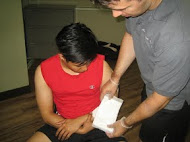Puncture wounds are deeps wounds that have a small entry hole, which are typically caused by a pointed object penetrating the skin. A puncture wound is different from a cut, which is a small tearing in the skin that does not create a hole in the skin. Moreover, a puncture wound is generally narrower and deeper than a minor cut or scrape. Punch wounds commonly occur with household or work items. Puncture wounds can usually be treated at home.
Causes of Puncture Wounds
The most common objects involved in puncture wounds are sharp objects such as, nails, knives, tacks, ice picks, teeth, and needles. The following are the common causes of puncture wounds:
- Human and animal bites
- Car accidents
- Falling or stepping on sharp objects
- Broken glass
- Stab or gunshot wounds
Signs and Symptoms of Puncture Wounds
Puncture wounds are typically very evident. Signs and symptoms of puncture wounds include:
- Small hole in the skin
- Bleeding
- Pain
- Drainage of fluid
Puncture wounds are at greater risk of infection because they are an ideal growing environment for bacteria. Moreover, they are also more difficult to clean. The most common bacterium that causes infection is Pseudomonas. One must be on lookout for signs of infection, which include:
- Redness, warmth, or swelling in the affected area
- Pus or discharge coming from the cut or scrape
- Fever
- Increased pain
When to Seek Medical Help Regarding Puncture Wounds
If any of the following signs are observed in relation to puncture wounds, seek medical help:
- The object that caused the puncture is difficult to remove
- Deep wound on the face or touching the bone
- Evidently dirty wound
- Human or animal bite
- Wound is from the bottom of a shoe – stepping on a nail
First Aid Management of Puncture Wounds
In cases of puncture wounds, do the following guidelines to help treat and manage these kinds of wounds:
- If the object is small and can be easily removed, do so.
- Stop the bleeding by applying direct pressure using a sterile gauze or clean cloth.
- Rinse the wound under clean water for several minutes. Wash the area with mild soap and water then rinse again.
- After cleaning the wound, apply a thin layer of antibiotic cream or ointment to keep the surface moist. This will help avoid infection.
- Make use of a sterile bandage to protect the puncture wound from harmful bacteria.
- If there is pain, take ibuprofen or paracetamol.

Puncture wounds are deep, narrow wounds that are caused by the penetration of a sharp object through the skin. To learn how to properly apply first aid in puncture wounds and other types of wounds, enroll in First Aid Courses.
Online Sources:
https://www.healthlinkbc.ca/kb/content/symptom/pntwd.html
http://www.webmd.com/first-aid/puncture-wound-treatment
https://www.lakeviewhealth.org/upload/docs/Puncture%20Wounds.pdf